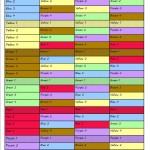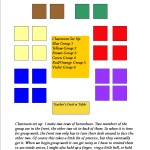By Deann Marin at The Best of Teacher Entrepreneurs

Offering for Educators, Comprehensive Teaching Aides. If you’d like to see what else I have to offer please visit my store.
I found that having children work in small collaborative groups made learning fun for both myself and the class. Interpersonal development is essential for students as they need to learn how to relate to each other in a positive way, small group activities allow them to do this effectively.
Group Structure: As I approach the new school year and get ready for my class, I look at last year’s teacher’s recommendations to help figure out levels, once that is done, I make groups with one high level child, two with average ability and one lower level child. I also try to have 2 boys and 2 girls in each group. That way there is diversity in abilities and they can all help each other. I found that the best arrangement for groups is no more than 4 so if I have 25 students I will make 6 groups of 4 and one with 5. Each group remains the same for one semester, and then we rotate. We would change groups 4 times throughout the year since we had 4 semesters. I liked having them work together for at least two months, getting to know each other, cooperating and allowing each child a chance to be heard. Of course there are always one or two kids that have a hard time working with others. If that occurs, you might pull them from the group and have them work on their own, esp if they are disruptive, until they can prove that they are able to work within a group. Setting up the rotations takes a bit of work since you don’t want to have the same kids in the group more than once. *See diagram.
Participation: Each child in the group has a particular job to do: leader, complimenter, secretary, person to pass things out, person to clean up, presenter, etc. Make sure that you let them know exactly what is expected of them. Depending on the lesson, we play the pencil game, one person holds a pencil and it is their turn to do the talking, when they are done the pencil is passed to the next child, and so on. Everyone has a turn. Sometimes they will write a group report and to make sure that everyone contributes, they have to initial the part that they have written.
Since it is important to put 1 high level, 1 low level, and 2 average students in each group, you might want to assign them a color and a number. For example: Jane is a bright student, assign her blue 1: Kathy really struggles, assign her blue 4; John and Adam are average students, they would be assigned blue 2 and 3. When you do each rotation, you would need to make sure that they are with different classmates and labeled accordingly. Keep the number code to yourself, the class should know their color code.
Classroom set up: I make two rows of horseshoes. Two members of the group are in front, the other two sit in back of them. So when it is time for group work, the front row only has to turn their desk around to face the other two. Of course, this takes a bit of practice, but they eventually get it. When we begin group work, it can become noisy, so I have to remind them to use inside voices, I might hold up a finger, ring a bell, or hold up a QUIET sign. You can also reward the quietest group with something that they would like. Since it is important to put high level, 1 low level and 2 average students in each group, you might want to assign them a color and a number. For example: Jane is a bright student, assign her blue 1; Kathy really struggles, assign her blue 4, John and Adam are average students, they would be assigned blue 2 and 3. When you do each rotation, you would need to make sure that they are with different classmates and labeled accordingly. Keep the number code to yourself, the class should know their color code.
If you’d like to see a complete lesson using this technique please see my bundle, What is it Like to be an Archaeologist?
This post is part of a blog hop called Sharing is caring. Please take a look at these awesome blogs from some amazing educators.
Please Visit Socrates Lantern’s Social Media Sites











